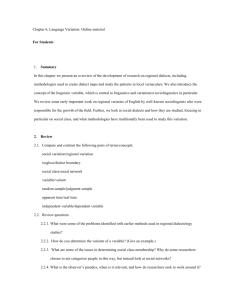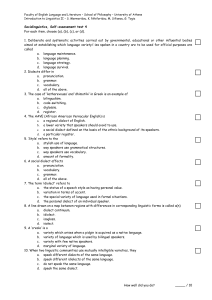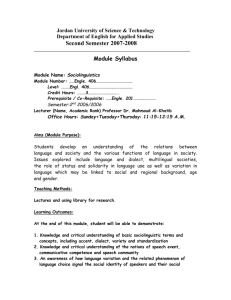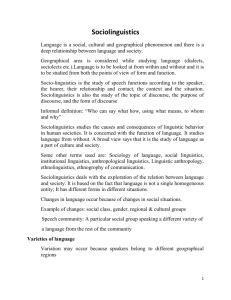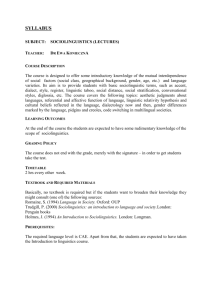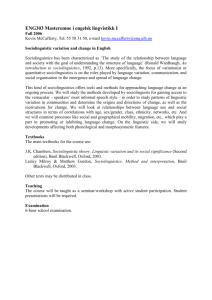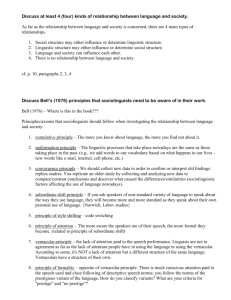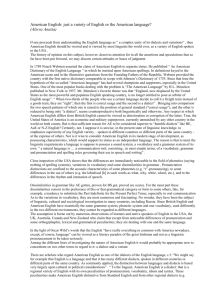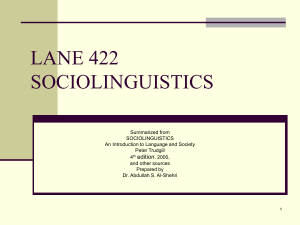Lecture Thirteen: Sociolinguistics Part I
advertisement
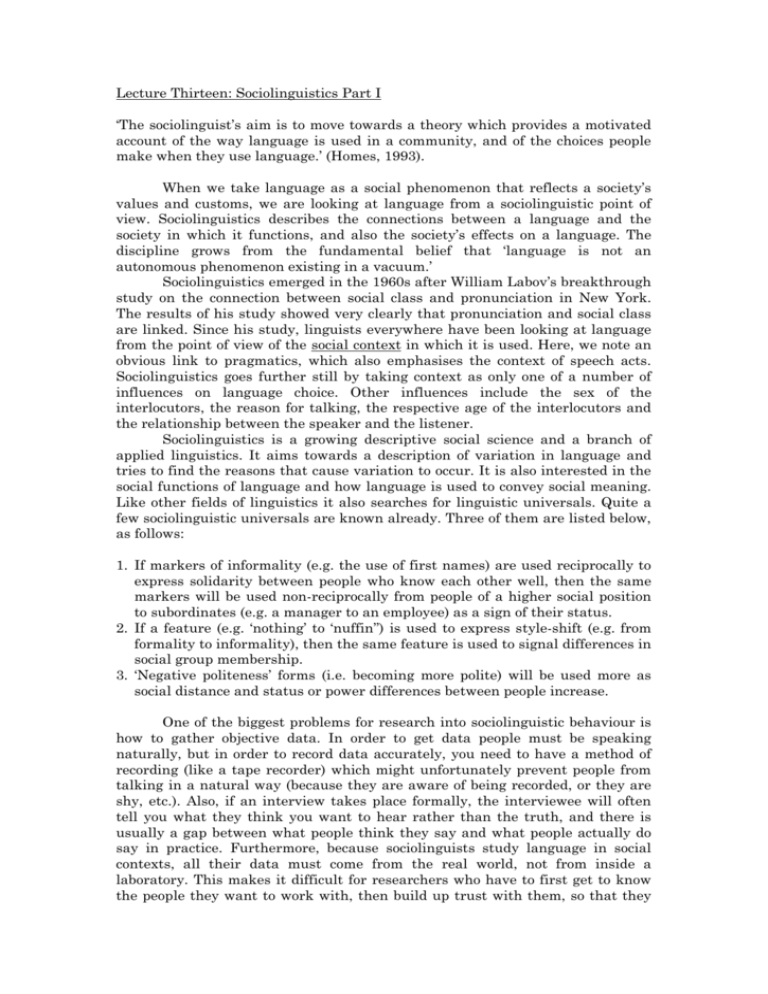
Lecture Thirteen: Sociolinguistics Part I ‘The sociolinguist’s aim is to move towards a theory which provides a motivated account of the way language is used in a community, and of the choices people make when they use language.’ (Homes, 1993). When we take language as a social phenomenon that reflects a society’s values and customs, we are looking at language from a sociolinguistic point of view. Sociolinguistics describes the connections between a language and the society in which it functions, and also the society’s effects on a language. The discipline grows from the fundamental belief that ‘language is not an autonomous phenomenon existing in a vacuum.’ Sociolinguistics emerged in the 1960s after William Labov’s breakthrough study on the connection between social class and pronunciation in New York. The results of his study showed very clearly that pronunciation and social class are linked. Since his study, linguists everywhere have been looking at language from the point of view of the social context in which it is used. Here, we note an obvious link to pragmatics, which also emphasises the context of speech acts. Sociolinguistics goes further still by taking context as only one of a number of influences on language choice. Other influences include the sex of the interlocutors, the reason for talking, the respective age of the interlocutors and the relationship between the speaker and the listener. Sociolinguistics is a growing descriptive social science and a branch of applied linguistics. It aims towards a description of variation in language and tries to find the reasons that cause variation to occur. It is also interested in the social functions of language and how language is used to convey social meaning. Like other fields of linguistics it also searches for linguistic universals. Quite a few sociolinguistic universals are known already. Three of them are listed below, as follows: 1. If markers of informality (e.g. the use of first names) are used reciprocally to express solidarity between people who know each other well, then the same markers will be used non-reciprocally from people of a higher social position to subordinates (e.g. a manager to an employee) as a sign of their status. 2. If a feature (e.g. ‘nothing’ to ‘nuffin’’) is used to express style-shift (e.g. from formality to informality), then the same feature is used to signal differences in social group membership. 3. ‘Negative politeness’ forms (i.e. becoming more polite) will be used more as social distance and status or power differences between people increase. One of the biggest problems for research into sociolinguistic behaviour is how to gather objective data. In order to get data people must be speaking naturally, but in order to record data accurately, you need to have a method of recording (like a tape recorder) which might unfortunately prevent people from talking in a natural way (because they are aware of being recorded, or they are shy, etc.). Also, if an interview takes place formally, the interviewee will often tell you what they think you want to hear rather than the truth, and there is usually a gap between what people think they say and what people actually do say in practice. Furthermore, because sociolinguists study language in social contexts, all their data must come from the real world, not from inside a laboratory. This makes it difficult for researchers who have to first get to know the people they want to work with, then build up trust with them, so that they will provide an objective source of material for analysis. Finally, recording someone in secret may be a good way to get genuine data, but it is also illegal and infringes upon a person’s right to privacy1, even if it does provide excellent research material. Such a dichotomy between the needs of the researcher versus the practical reality of the situation (and the law) is known as the ‘observer’s paradox’. Sociolinguists are mainly interested in speech rather than in writing, although interest in written English is growing. The standard variety of English has not been taken seriously in sociolinguistics until recently, when it was realised as a sociolinguistic phenomenon in its own right, in particular with regard to public attitudes towards it. Macro-sociolinguistics In macro-sociolinguistic studies, society is seen as a whole and research focuses on how language functions in it and on how language reflects social differentiation. E.g. the role of the standard variety of English in England, or sexism in English. Micro-sociolinguistics In micro-sociolinguistic studies, the focus is on how language functions in the communication between members of the society. E.g. how, when and why are native English speakers polite, or how and why does teen-speak alienate older generations (especially the parental generation). Variation, variety, variant and variable All languages vary internally. There are different types of pronunciation (accents), different dialects (e.g. Northumbrian, Mancunian and Liverpuddlian) different styles (e.g. formal, colloquial and informal), and even different standards in the case of some languages (e.g. English is one such pluricentric language with different standard varieties in America, England, Scotland, Australia and Canada, for example). When we talk about those kinds of differences in a language we mean linguistic variation. ‘Variation’ is just a technical term, meaning differences in general that occur within a language. It can be ‘any set of linguistic forms which patterns according to social factors’. Variation can also be referred to as a ‘code’, and ‘code-switching’ happens when a speaker varies his/her speech from one form to another. Code-switching involves changes in specific aspects of pronunciation, style, grammar and vocabulary. A specific aspect of a language that is subject to change under certain conditions is called a variant. For example, in English there is ‘variation’ of style (formal and informal). If someone is speaking informally, you may notice because the pronunciation of /t/ has two variants, one of which indicates informality: [ ]. If the same speaker then talks with another person who deserves more respect the /t/ sound will probably appear as [t] to show a greater degree of formality. Other examples of variants include the pronunciation of /-ing/ as either / / or / n/ in Norwich in the south-east of England. The former is a sign of greater formality, and is more common among women speakers and is a sign of a high social class, the latter is a feature common in the local dialect and is more common in men and is also a sign of a low social class. Another example is the presence or absence of [r] in New York. Note the beginning of the film ‘Pygmalion’ (based on the play by George Bernard Shaw) when Higgins causes a lot of trouble by trying to secretly record Eliza Doolittle’s speech out in the street. 1 If it is pronounced it usually signifies (careful) middle or upper class , if it is absent, then it can indicate a speaker is of a lower social status. When a sociolinguist is observing one specific linguistic point to discover the circumstances in which variation occurs he/she will keep all other features the same and experiment with one feature called a variable. For example, an observer may go to Yorkshire and listen for the presence or absence of the sound [h]. He/she will make a note of when it is pronounced and when it is dropped. [h] is the ‘variable’ that will tell the sociolinguist information about a speaker’s social class, social group, feeling of formality in a given situation and even his/her sex and level of education. In summary, a variable is something which is either present or not under certain circumstances. Regional dialect (regiolect) A regional dialect is a form of a language which is associated with a certain geographical region, or area, of a country. It differs from other varieties of the language particularly in terms of grammar, pronunciation and accent. Regional dialects are among the oldest studies into language since a broad interest in linguistics developed in the last century. At first regional dialects were studied for two main reasons: (a) the regional dialect was seen to be an older and ‘purer’ form of the language and so it was deemed worthy of recording and protecting, and (b) because broad regional dialects did tend to maintain older features of a language, studying them could help to unravel details about the history of the development of the language in general. Unfortunately, researchers tended to think that the dialect of the oldest man in the remotest village would be the only speaker worthy of investigation. The results of such studies never took into account the speech of women or of other age groups or a variety of social classes and were limited to a small percentage of the local population, thus rendering the results virtually meaningless. The results did help in the creation of dialect atlases that showed where rough boundaries between dialects could be found, and showed some other interesting results. For example, the importance of topographical barriers (e.g. mountains, rivers and lakes) on isolating dialects or, conversely, on creating greater mixing, which would eventually either prevent, slow down or speed up the process of spreading new words and the standard dialect. The possession of the standard would greatly influence a community’s ability to improve their social status and local economy. From a linguistic point of view it is perhaps not surprising then, that the mountainous north of England, far from London, is less economically developed than the flat lands of the south closer to London. Below are some of the features of the traditional West Riding Yorkshire dialect of north-east England compared with standard English: Grammar differences: ‘to go’ ‘modal verbs’ ‘verb forms’ ‘pronouns’ ‘negation’ Pronunciation: Yorkshire (West Riding) Dialect ‘Wheare’s tha bahn?’ ‘mun’ ‘break - brok - brokken’ ‘tha - thi - thine - thi’ ‘Ah din’t do nowt.’ vowel sounds are purer tones on some words convey much meaning, (e.g. ‘Ah!’) Much use of the glottal stop /h/ is frequently dropped words tend to run together: Standard English English ‘Where are you going?’ ‘must’ ‘break - broke - broken’ ‘you - you - yours - (to) you’ ‘I didn’t do anything’. quite a few ‘a’-type sounds, etc. Few words have a variety of tones conveying much meaning. only informal use of glottal stop /h/ is not dropped ‘stop talking and eat your Vocabulary: ‘shruppangerritetten!’ ‘sither 'ere’ t’ ‘laik’ ‘frame thissen’ ‘luv’ (a sign of friendliness) dinner’ ‘look here’ or ‘listen to me’ to ‘play’ ‘pull yourself together’ ‘love’ (signals romance) Social dialects (sociolects) Speakers of a language do not only have variation on a regional level, but also on a social level. This can include switching from formal to informal styles and copying middle class speech to give others a certain impression of yourself (either better or worse social status than you actually have), for example. Social dialects are not restricted to one area, but are used and known over the whole same language-speaking region. Sometimes people will change their speech to a more formal style to give a good impression to strangers, while keeping informal styles for familiar surroundings. In practice, a formal standard style is useful in important social situations like second and higher education, national government, interviews, public services and asking for favours. An informal and not necessarily standard variety of English is good between friends and family, in local government (when you want to identify with the voters) at work among colleagues, in shops with regular customers and in primary education sectors. In general women tend to be more aware of different social norms of language than men are, and tend to use a greater variety of language than men do. This may be due to the fact that women are more sensitive to feelings expressed through language and are generally more talkative in a social way than men. Female English speakers are particularly known for hyper-corrective linguistic behaviour. Hyper-correction is an attempt to sound more formal, but the attempt goes beyond the actual degree of formality that is expected and so sounds even more formal. This is common when working-class women want to sound like middle-class women for certain social advantages (e.g. getting a better job). There tends to be a correlation in English between social class and the varieties of English spoken. Generally, the higher the social class, the less nonstandard varieties are used: Highest class: standard dialect Social variation Lowest class: localised, non-standard dialects. Regional variation (After Peter Trudgill) Idiolect This is the variety of a language spoken by an individual. The features unique to the way in which one person speaks (e.g. using a certain expression frequently which other speakers would not use and the timbre of the voice, and so on). Language and gender The topic of language being sexist is a big one, and so we shall only mention a few things here. Because language reflects the social values and way of life of a community, it is only natural that it will also reflect sexism which is also found in other aspects of society. Similarly language itself can influence the way society functions and shapes social values and attitudes. Here are a few English examples that show possible elements of sexism in the language: 1. Generic ‘he’ has long been used to stand for men and women in cases where the actual sex of the referent is unknown. E.g. ‘If a person wants to be a doctor he must study very hard.’ But how many of us would consider that ‘doctor’ could also be female in the last example? 2. The suffix ‘-man’ (pl. ‘-men’) is often used to stand for both men and women who do a certain job. E.g. ‘businessmen’, ‘policemen’, ‘fireman’ and ‘postman’. 3. Swearing is traditionally seen as a male speech form only. Possible solutions: 1. Use ‘they’ instead of ‘he’ in generic situations as is quite normal in speech. E.g. ‘What does a doctor do? - They work in hospitals.’ 2. Also use the suffix ‘-woman’ (pl. ‘women’), or use a neutral suffix ‘-person’ (pl. ‘people’) in addition to ‘-man’ to indicate job descriptions. E.g. ‘chairman, chairwoman, chairperson’ and ‘chair’. 3. In fact, women swear at least as much as men (especially today as a sign of women’s emancipation and equal status with men). The difference really lies in the type of swear words used. Men tend to use more sexual words, women tend to use more words related to God. Obviously, sexism does exist in language and attempts to readdress the balance have been successful. Unfortunately you cannot force someone to speak differently, although you can set a good example for others to follow. In these kinds of linguistic areas (incl. sexism and racism, etc.) social change must also come hand in hand with linguistic change. One cannot exist without the other. If people’s ideas change, then language will change to reflect the changes; if better language can be encouraged, ideas can also begin to change as a result especially in the case of bringing up young children. Language and age Age can affect language greatly. It is readily observed that teenagers speak differently from older generations and that very young children clearly speak differently from older children. Language in that case is a sign of identification with a group of people who share similar life experiences, philosophies and desires, and also a similar level of maturity. Below are some common examples and comments: (a) Young children: they use lots of diminutives and onomatopoeic repetitions, there are also signs of a still developing sound system and an incomplete grammar: ‘daddy’ (= father), ‘mummy’ (= mother), ‘choo-choo’ (= train), ‘bwana’ (= banana), ‘chockie’ (= chocolate), ‘sweetie’ (= sweets), ‘bockel’ (= bottle), ‘my car’ (= ‘look! that’s my toy car’, or ‘give me my toy car’). (b) Teenagers: they tend to use a lot of expressions to alienate themselves from grown ups and children: ‘it’s wicked, man!’ (=it’s great fun!), ‘no, don’t think so!’ (= I disagree with you very strongly), ‘get a life!’ (= behave in a fashionable, trendy or ‘cool’ way and not like a bore or a mature adult). (c) Parents: apart from a more mature form of speech with more complex words and ‘old-fashioned’ phrases, parents sometimes display a patronising attitude towards the young and a child-like manner with babies: ‘when I was your age…’ (= when I was younger people never behaved as badly as you), ‘yes, aren’t you a beautiful little baby boy, then; coochie-coochie-coo’ (= no real meaning, just showing some attention to the baby). In-grouping and out-grouping If a group of people want to show they all belong to the same group sharing a common interest, purpose or identity they will probably show it by the language they use. If they don’t want anyone outside the group to understand they will purposely use language that alienates others (‘out-grouping’) but brings them closer to each other (‘in-grouping’). For example, academics talking about some complex theory together will use lots of technical terms that no one else understands, in Wales some Welsh speakers are known to switch from English to Welsh if an English person is present to show their separate nationalistic identity, and criminals may use a form of rhyming slang (called an ‘argot’) so that the police won’t know what they are doing or planning to do, etc.. Social Networks A final very important underlying notion in sociolinguistics is that concerned with social networks. The Milroys did research in Belfast to try and discover how words used by Protestants came to be used by Catholics who lived in very separate communities. It was discovered that Protestant men and Catholic women were working in the same factory and words used by Protestants were passed on to Catholics at work who then spread the new words to their own communities. This discovery revolutionised the way we understand how linguistic change happens. The model used to describe it is networking. If A uses a new word with B and B uses it with C (whom A doesn’t know) and C starts to use it, then the word can spread further from C to D and so on, until the word or expression becomes a part of everyone’s linguistic repertoire, and eventually enters the standard language (by being widely used over an extended time period and then codified in dictionaries). Model 1: Social Networks A B B C C C C D D ……… etc.


